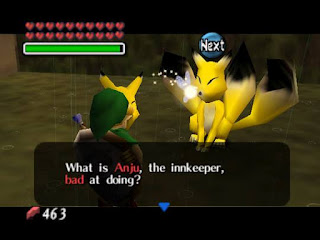How do you create a follow-up to one of the greater successes of the video game industry? If The Legend of Zelda: Majora’s Mask is any indication, you reuse much of the same assets and launch it less than two years after its predecessor. Here’s the kicker: you reimagine everything else.
 Even with all the time in the world, you can’t afford to fool around. Many events, including the daily routines of the folks in Clock Town, are dictated by the game’s timer. Your three day cycles often revolve around fulfilling objectives at certain times and many of the tasks that span multiple days will not reward you for dawdling.
Even with all the time in the world, you can’t afford to fool around. Many events, including the daily routines of the folks in Clock Town, are dictated by the game’s timer. Your three day cycles often revolve around fulfilling objectives at certain times and many of the tasks that span multiple days will not reward you for dawdling. Dungeons are still present, but they’re nowhere as imperative as in other Zelda games. In fact, there are only four “real” ones, compared to the standard 7-10. If you’ve never played the series before, these are essentially enclosed areas that require you to solve overarching puzzles that mandate the use of items and masks. Each one rewards you with a new item (or mask) that can be used against the dungeon boss. Once you’ve laid waste to the beast, the area surrounding the temple will return to its natural state.
Dungeons are still present, but they’re nowhere as imperative as in other Zelda games. In fact, there are only four “real” ones, compared to the standard 7-10. If you’ve never played the series before, these are essentially enclosed areas that require you to solve overarching puzzles that mandate the use of items and masks. Each one rewards you with a new item (or mask) that can be used against the dungeon boss. Once you’ve laid waste to the beast, the area surrounding the temple will return to its natural state.  While tactical players could finish the game in less than 15 hours, Majora’s Mask offers far more in terms of content. Besides, the purpose here is to participate in side-quests and explore the world – rushing through the game is counterintuitive. Majora boasts 52 heart pieces to collect, 60 stray fairies, 24 masks, countless mini-games, hidden items, bonus dungeons, and item upgrades. In simpler terms, that means there’s never a loss for things to do. You could easily clock in (heh) at 50 or more hours if you’re trying to collect everything.
While tactical players could finish the game in less than 15 hours, Majora’s Mask offers far more in terms of content. Besides, the purpose here is to participate in side-quests and explore the world – rushing through the game is counterintuitive. Majora boasts 52 heart pieces to collect, 60 stray fairies, 24 masks, countless mini-games, hidden items, bonus dungeons, and item upgrades. In simpler terms, that means there’s never a loss for things to do. You could easily clock in (heh) at 50 or more hours if you’re trying to collect everything. 








I approve of everything here. Majora's Mask is my favorite Zelda title, it is a steal at $10.
Thanks for dropping by and your comment, Mia!
Agree with you completely that $10 is an utter bargain.
I wish the Virtual Console version was tracked on the Nintendo Channel. It'd be interesting to see how many hours I put into it and how many times I played it.
I find it a little funny to see this article here as I've just replayed (and completed) Majora's Mask last week. Which in turn resulted in me being fascinated by the Happy Mask Salesman character, who certainly is hiding quite a bit of things from Link. Quite sad that this NPC hasn't come back since Majora's Mask, or at least revealed a bit more information about who he is. (The only NPC in Majora's Mask, besides Tatl, to be unaffected by Time). All these questions will likely never be answered sadly.
Oh, and good review!
I wonder if Majora's Mask is the game that gamers most want a sequel to from the Zelda series?
It'd have to be right up there!
Thanks for the comment and your story 😀
There is actually 61 stray fairy's in the game the 60 you listed plus the one in clock town
durandle